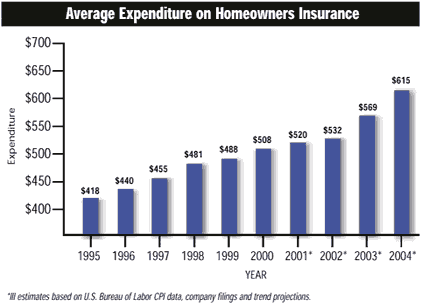Rapidly rising construction costs, home remodeling and increasingly expensive natural disasters are expected to push the cost of homeowners insurance up by 8 percent in 2004, according to a report by the Insurance Information Institute (I.I.I.)
The projected increase represents a modest change from the estimated 7 percent increase in 2003, noted the I.I.I. The average cost for home insurance nationwide for 2004 is projected to be $615 -an increase of $46 for the average homeowner over this year.
“Part of the increase reflects choices more homeowners are making,” said Robert Hartwig, senior vice president and economist for the I.I.I. “People are taking advantage of record low interest rates and are moving into new homes or making additions to their existing homes in near record numbers. These upgrades and additions are pushing up insurance costs. However, reflecting the value of homeowners insurance, the cost of protecting the most important financial asset that American families have is less than one-half of one percent of the market value of the average existing home in the United States. People expect their premium rates to stay the same, but they don’t realize they have more house to insure.”
Rapidly rising home prices are a prime factor in rising homeowners’ insurance costs.
Since 1995, the median price of an existing home has risen by nearly $60,000. New home prices are rising at a significant pace. The boom in mortgage refinancing is also contributing to higher insurance costs as homeowners use their savings to tap into home equity lines of credit to build additions, remodel and update their homes, adding to their value.
According to a research report issued in February by Harvard’s Joint Center for Housing Studies, http://www.nari.org/innerspace.cfm, home improvement “has become the great national pastime.”
Approximately 41 million homeowners have added to or improved their homes between 2001 and 2002. In 2001, the most recent year for which annual figures were available, an estimated $214 billion was spent on home improvements, maintenance and repairs (including by owners of rental properties).
“The stock market bust has created a home sale boom in recent years,” added Hartwig. “Because of historically low interest rates, more of us are either adding on to existing homes or buying larger homes. It goes without saying that more expensive homes contribute to higher insurance costs because insurers are asked to take on greater risk.”
According to the I.I.I., between 1990 and 2002, home insurers paid out, on average, $1.167 in losses and expenses for every $1 they earned in premiums. In 2002 alone, home insurers paid out $4.73.5 billion more in losses and expenses than they received in premiums. In 2001, home insurers lost $7.43 billion, the second worst year on record (the highest is 1992, which included Hurricane Andrew, produced losses of $11.5 billion). Losses in the homeowners’ insurance line over the past four years (2000 through 2003) are estimated at $187 billion, approaching the level of insured property losses from the Sept. 11 terrorist attack.
Approximately 41 million homeowners have added to or improved their homes between 2001 and 2002. Also during the 1990s, the severity of catastrophes began to increase dramatically. Since 1990, insurers have reportedly paid out more than $100 billion in catastrophe-related losses – or about $700 million per month.
“Homeowners insurance rates in many parts of the country continue to rise because of the extraordinary costs associated with paying these claims,” said Hartwig. “In fact, virtually every part of the country is either at risk of or has experienced a billion dollar disasters.”
Another issue, mold in homes, is not new. However, increased public anxiety stemming from publicity surrounding high profile lawsuits in Texas and California has increased the risk associated with water damage across the country.
“There is no new ‘killer mold’ out there,” continued Hartwig. “But the sharp rise in mold claims is definitely a 21st century phenomenon. Unfortunately, so are multi-million dollar jury awards associated with mold,” he said. “No one wants to see the virtual collapse of the insurance market in Texas happen anywhere else, so steps are being taken to limit coverage and contain mold costs. But we are still in a situation where any water damage claim anywhere in the country can produce a million dollar lawsuit. Insurers have to factor that into the cost of insurance.”
In Texas, for example, mold was not a market factor until 2001, when claims shot up to $1 billion. In 2002, mold costs surged to $2.3 billion, according to figures from the Texas Department of Insurance.
While the typical American homeowner will pay (see graph) $569 in 2003 and $615 in 2004, rates do vary significantly from one part of the country to another.

Topics Texas Homeowners
Was this article valuable?
Here are more articles you may enjoy.


 Allstate Reports $731M in Q1 Pretax Catastrophe Losses
Allstate Reports $731M in Q1 Pretax Catastrophe Losses  FBI Says Chinese Hackers Preparing to Attack US Infrastructure
FBI Says Chinese Hackers Preparing to Attack US Infrastructure  AIG General Insurance Chairman McElroy to Retire May 1
AIG General Insurance Chairman McElroy to Retire May 1  Former Congressman Charged After Collision with State Trooper in Florida
Former Congressman Charged After Collision with State Trooper in Florida 


